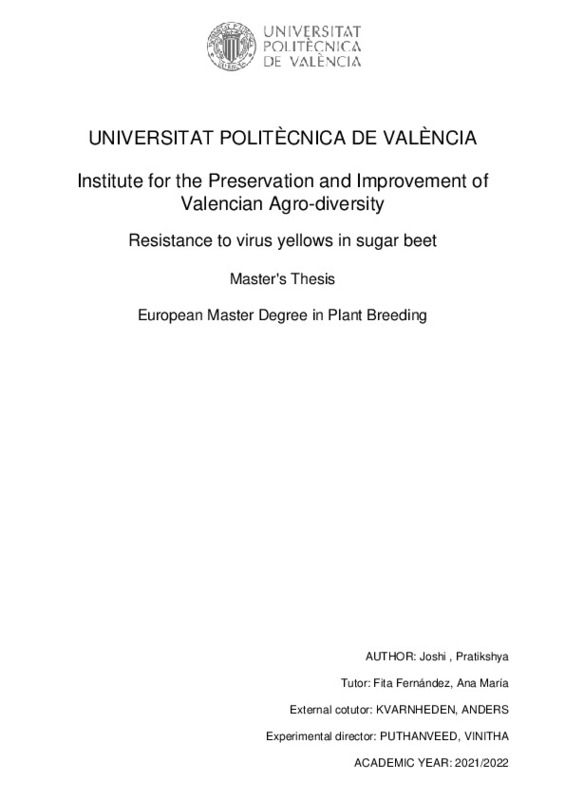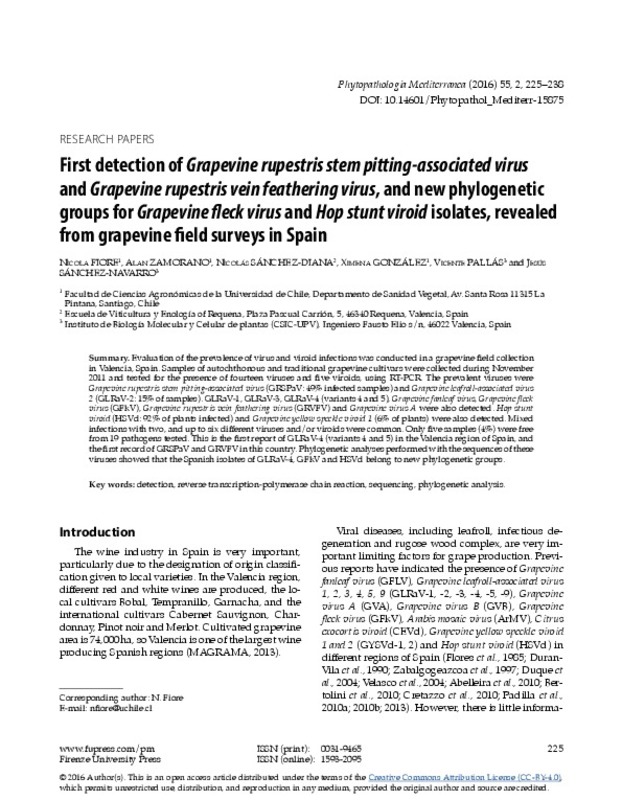JavaScript is disabled for your browser. Some features of this site may not work without it.
Buscar en RiuNet
Listar
Mi cuenta
Estadísticas
Ayuda RiuNet
Admin. UPV
Resistance to Virus Yellows in Sugar Beet
Mostrar el registro sencillo del ítem
Ficheros en el ítem
| dc.contributor.advisor | Fita Fernández, Ana María
|
es_ES |
| dc.contributor.advisor | Kvarnheden, Anders
|
es_ES |
| dc.contributor.advisor | Puthanveed, Vinitha
|
es_ES |
| dc.contributor.author | Joshi, Pratikshya
|
es_ES |
| dc.date.accessioned | 2022-10-21T09:27:22Z | |
| dc.date.available | 2022-10-21T09:27:22Z | |
| dc.date.created | 2022-09-29 | |
| dc.date.issued | 2022-10-21 | es_ES |
| dc.identifier.uri | http://hdl.handle.net/10251/188503 | |
| dc.description.abstract | [ES] La remolacha azucarera (Beta vulgaris), un cultivo bienal de la familia Amaranthaceae, se cultiva para obtener azúcar. El virus del amarilleo es una enfermedad que afecta a la remolacha azucarera con gran impacto económico. Es causada por un complejo de virus, a saber, el virus del amarillo de la remolacha (BYV), el virus del amarillamiento leve de la remolacha (BMYV), el virus de la clorosis de la remolacha (BChV), el virus del mosaico de la remolacha (BtMV), el virus del amarillo occidental de la remolacha (BWYV) y el virus del amarillamiento de la hoja (BLYV). Los neonicotinoides habían sido una medida de control efectiva para prevenir la transmisión de amarillamiento mediada por áfidos hasta su prohibición casi total por parte de la UE en 2018. La producción de remolacha azucarera es vulnerable a los virus amarillos ya que aún no se han lanzado cultivares resistentes, y el mecanismo de resistencia de las plantas contra los virus amarillos no se conoce completamente. Este proyecto tiene como objetivo comprender el mecanismo de resistencia de la remolacha azucarera y, finalmente, desarrollar cultivares resistentes utilizando la fuente silvestre resistente identificada. Para ello, se llevó a cabo un experimento de inoculación mediada por áfidos de BMYV y BYV, que contenía tres tratamientos (áfidos virulentos, áfidos sanos y spray insecticida), para genotipos silvestres resistentes y élite susceptibles. El ARN total (que contiene ARN tanto de la planta como del virus) extraído de estas muestras se sometió a secuenciación y análisis de ARN para determinar los genes expresados diferencialmente en diferentes genotipos, tratamientos y puntos temporales. Se sintetizó ADNc y se realizó RT-qPCR para cuantificación absoluta para determinar el título del virus en plantas resistentes y susceptibles inoculadas con BMYV. Además, se realizó RT-qPCR para la cuantificación relativa para determinar la expresión diferencial de los genes relacionados con la patogenia AGO1, PR1a y PR5 en las plantas sanas inoculadas y no inoculadas con virus en diferentes momentos. El título del virus fue mayor en las plantas susceptibles en comparación con las plantas resistentes. Los genes PR1a y PR5 no se expresaron en la mezcla de ADNc de muestras de genotipos resistentes y susceptibles. Mientras tanto, en plantas susceptibles, AGO1 mostró una mayor expresión en plantas sanas en comparación con las plantas inoculadas. En plantas resistentes, probablemente se expresó, pero no pudo detectarse usando cebadores diseñados para remolacha azucarera cultivada. Para estudiar la expresión génica en el genotipo resistente, será necesario diseñar nuevos cebadores, lo que podría hacerse utilizando los datos de secuencia obtenidos para el genotipo resistente. | es_ES |
| dc.description.abstract | [EN] Sugar beet (Beta vulgaris), a biennial crop from the Amaranthaceae family, is cultivated for sucrose. Virus yellows is an economic disease affecting sugar beet. It is caused by a complex of viruses, namely, beet yellows virus (BYV), beet mild yellowing virus (BMYV), beet chlorosis virus (BChV), beet mosaic virus (BtMV), beet western yellows virus (BWYV) and beet leaf yellowing virus (BLYV). Neonicotinoids had been an effective control measure preventing aphid-mediated transmission of virus yellows until their near-total ban by the EU in 2018. Sugar beet production stands vulnerable against virus yellows as no resistant cultivars have been released yet, and the resistance mechanism of plants against virus yellows is not fully known. This project aims to understand the resistance mechanism of sugar beet and eventually develop resistant cultivars using the identified wild resistant source. For this purpose, an experiment involving aphid-mediated inoculation of BMYV and BYV, containing three treatments (virulent aphids, healthy aphids, and insecticide spray), was carried out for susceptible elite and resistant wild genotypes. The total RNA (containing RNA from both the plant and the virus) extracted from these samples went through RNA sequencing and analysis to determine the differentially expressed genes across different genotypes, treatments and time points. cDNA was synthesised, and RT-qPCR for absolute quantification was performed to determine the virus titre in BMYV inoculated resistant and susceptible plants. Furthermore, RT-qPCR for relative quantification was performed to determine the differential expression of the pathogenesis-related genes AGO1, PR1a, and PR5 in the virus inoculated and non-inoculated healthy plants at different time points. The virus titre was higher in susceptible plants as compared to resistant plants. The genes PR1a and PR5 were not expressed in the cDNA mix of samples from resistant and susceptible genotypes. Meanwhile, in susceptible plants, AGO1 showed increased expression in healthy plants compared to inoculated plants. In resistant plants, it was probably expressed but probably could not be detected using primers designed for cultivated sugar beet. For studying gene expression in the resistant genotype, it will be necessary to design new primers, which could be done using obtained sequence data for the resistant genotype. | es_ES |
| dc.format.extent | 50 | es_ES |
| dc.language | Inglés | es_ES |
| dc.publisher | Universitat Politècnica de València | es_ES |
| dc.rights | Reserva de todos los derechos | es_ES |
| dc.subject | Virus amarillo | es_ES |
| dc.subject | Remolacha azucarera | es_ES |
| dc.subject | BMYV | es_ES |
| dc.subject | BYV | es_ES |
| dc.subject | RT-qPCR | es_ES |
| dc.subject | Secuenciación del ARN | es_ES |
| dc.subject | Cuantificación absoluta | es_ES |
| dc.subject | Cuantificación relativa | es_ES |
| dc.subject | Sugar beet | es_ES |
| dc.subject | Virus yellows | es_ES |
| dc.subject | Absolute quantification | es_ES |
| dc.subject | Relative quantification | es_ES |
| dc.subject | RNA sequencing | es_ES |
| dc.subject | Reverse transcription quantitative polymerase chain reaction | es_ES |
| dc.subject | Beet yellows virus | es_ES |
| dc.subject | Beet mild yellowing virus | es_ES |
| dc.subject.classification | GENETICA | es_ES |
| dc.subject.other | Máster Universitario Erasmus Mundus en Mejora Genética Vegetal / Erasmus Mundus Master Programme in Plant Breeding - emPLANT-Màster Universitari Erasmus Mundus en Millora Genètica Vegetal / Erasmus Mundus Master Programme in Plant Breeding - emPLANT | es_ES |
| dc.title | Resistance to Virus Yellows in Sugar Beet | es_ES |
| dc.title.alternative | Resistencia al virus amarillo en la remolacha azucarera | es_ES |
| dc.title.alternative | Resistència al virus groc en remolatxa sucrera | es_ES |
| dc.type | Tesis de máster | es_ES |
| dc.rights.accessRights | Abierto | es_ES |
| dc.contributor.affiliation | Universitat Politècnica de València. Departamento de Biotecnología - Departament de Biotecnologia | es_ES |
| dc.description.bibliographicCitation | Joshi, P. (2022). Resistance to Virus Yellows in Sugar Beet. Universitat Politècnica de València. http://hdl.handle.net/10251/188503 | es_ES |
| dc.description.accrualMethod | TFGM | es_ES |
| dc.relation.pasarela | TFGM\151169 | es_ES |









